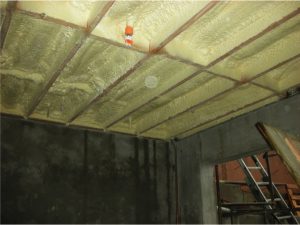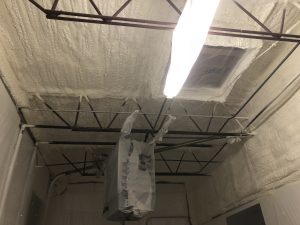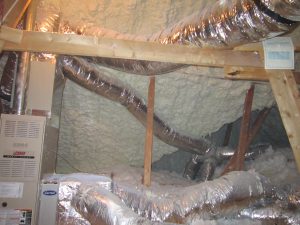At Energy Consulting Services, we strive to help homeowners and business owners maximize energy efficiency and comfort. Spray foam is widely regarded as the best form of insulation on the market today. Encapsulating your attic or crawlspace in spray foam provides an excellent alternative to traditional fiberglass insulation. In an attic space, spray foam is applied directly to your roofline instead of the attic floor. This brings the attic space into the building envelope, which means that the attic will no longer get hot or cold. This ensures that you will not lose heat or AC through ceiling penetrations or via radiant heat transfer. Attic encapsulation translates to significant reduction to heating and cooling costs.
In the crawlspace or vented basement, applying spray foam along the subfloor or along the foundation walls is extremely effective with keeping the floors from getting cold in winter and also in improving air quality by sealing off the living space from the earthen floor. If your HVAC and ductwork are located in the attic or crawlspace, they will operate much more efficiently in an encapsulated space since it is a moderate temperature environment. This translates to increased temperature consistency and lower heating and cooling bills.
Locations for use
As a general rule, all forms of insulation are most effective in areas particularly at risk for heat transfer, and spray foam is no exception. However, unlike other insulation products such as fiberglass, spray foam comes out as a liquid and gets into the cracks and penetrations and then solidifies. This makes spray foam an excellent air sealing product as well as insulator. Target regions for spray foam application include:
Attics
Attics in the north Georgia climate get as hot as 135 degrees and cold as 40 degrees. These extreme temperatures force the HVAC and ductwork to work extra hard to pump cool air through a hot space or warm air through a cold space. In an encapsulated attic or crawlspace, the temperature stays moderate which maximizes efficiency and allows your HVAC system to work less to meet the set temperature. This not only translates to lower heating and cooling bills, this also extends the operating lifespan of your HVAC system.
Crawl spaces
Some crawl spaces are best served by applying closed cell spray foam directly to the subfloor to seal off the living space from the crawl space entirely. Besides insulating the floors, foam seals up all the cracks and penetrations and it will last for a lifetime. Additionally, closed cell foam doubles as air and vapor barrier, firms up the soft spots in the floor, and makes it very hard for bugs or critters to penetrate.
Other crawlspaces are best served by encapsulation. This entails installing a string enforced high quality vapor barrier sealed at all seams and at least 6” up the walls and piers so no earthen floor is exposed. Closed cell spray foam is then applied directly along the foundation walls and piers to adhere the vapor barrier in place and seal out moisture from the foundation walls. Encapsulation is only done when HVAC is in the crawlspace since it is very beneficial to bring the HVAC and ductwork into a clean moderate temperature environment. Our detailed energy audit will determine what solution will be most effective for your home or building.
Why choose spray foam insulation
Spray foam insulation is gaining a lot of popularity in the housing industry. Because of its unique chemical properties, it brings amazing energy saving benefits. The airtight seal of foam insulation dramatically improves air quality. Fiberglass insulation has a lower sound barrier, leaks air, and lasts 50 years less than spray foam. Spray foam insulation makes for a more comfortable home easier to retain heat and air conditioning, reduces energy costs, and the product is under lifetime manufacturers warranty – you will never have to insulate again!
Spray types and application process
Ready to insulate with spray foam? The two primary types of spray foam insulation are open cell and closed cell sprayfoam. (also known as low density and high density foam) For attic encapsulation, open cell spray foam is used since it is water permeable. This means that if you have a roof leak, the water will drip through and you’ll see a spot on your ceiling so you’ll know to have it addressed. Open cell foam is also used in wall cavities.
Closed cell foam is very dense and doubles as both an air and vapor barrier. Closed cell foam is used under subfloors and along foundation walls to complete crawlspace encapsulation. The vapor barrier quality is a big advantage in this case. However, closed cell foam is slightly more expensive than open cell foam.







